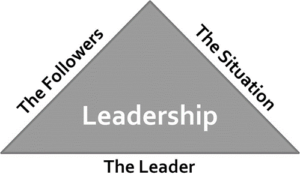The Three Components of a Leadership Situation
The following is an excerpt from: Lead from Strength – Mastering the 9 Components of Extraordinary Leadership, our new book on leadership excellence. In our book we define leadership using the quote from Dwight David Eisenhower who said, “Leadership is the art of getting someone else to get something done, as if he wants to do it.” Thus, given this definition, it is critical that leaders understand the leadership situation so they can clearly define just what they need done.
The excerpt that follows outlines the factors that must be understood about any business situation so leaders can effectively communicate what needs doing to those they lead.
The first theme of the definition of extraordinary leadership focuses on the leadership situation, as shown in the diagram below:
For any given situation, such as an organizational goal, sales objective, performance improvement plan or special volunteer project, the goal is for the leader to lead their followers to achieve success in the situation, however that success is defined.
Each of these components of the leadership situation have certain factors that define and influence them, as explained in the next two sections.
The Five Factors of the Situation
There are five factors influencing a given leadership situation and each needs to be considered, defined and clearly understood in order to successfully lead others through them:
- What is the situation? What specific issue, problem or opportunity needs to be resolved or taken advantage of? It is imperative to understand and clearly state, in writing, a clear identification of the “who, what, when, why, where and how” of the issue at hand.
- What is the vision of the outcome desired? Define a clear and compelling vision of the outcome desired, and how success is measured. It is how we know when the issue is resolved, and therefore we have won the day.
- What are the actions and steps needed to achieve success? In short, define the plan of action needed to achieve the vision of success desired.
- What human skills are needed for success? Irrespective of the individuals who may eventually be assigned to the situation, what human resources (talents, skills, experience, temperament, attitude, etc.) are needed to accomplish the defined actions to achieve the stated vision of success?
- What non-human resources are needed for success? These are the resources other than human talent needed to complete the defined actions most productively, to achieve the stated vision of success. This is generally the intangible, tangible, and financial resources needed for success.
The job of the leader, therefore, is to first define these five factors. In fact, depending on the strengths of that particular leader, the first task may be to lead a group of followers, or the person(s) assigning you as leader (for example, your boss), to clearly define these factors. You don’t have to do this alone! The essential point in defining the leadership situation, given our definition of leadership, is this:
To get the things you want done, those you lead need to know just what “done” is.
The extraordinary leader understands how important this is, and intentionally stops and takes the time needed to clearly define the leadership situation.
In our work with business owners and other leaders, they quickly come to realize that clearly identifying the situation and defining “done” is the single greatest factor contributing to their leadership success…or conversely, the single greatest contributor to any past lack of success. It is rather simple; unless you clearly define what you want done, you cannot expect those you lead to get it done.

